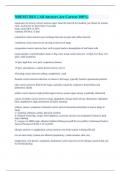NREMT BLS || All Answers Are Correct 100%.
mnemonic for airway correct answers open: head tilt chin lift for medical, jaw thrust for trauma
clear: suction for no more than 15 seconds
keep: insert OPA or NPA
ventilate: BVM at 15 lpm
respiration correct answers gas exchange between oxygen and carbon dioxide
ventilation correct answers air moving in and out of lungs
oxygenation correct answers how well oxygen binds to hemoglobin of red blood cells
nasal cannula vs nonrebreather mask vs bag valve mask correct answers 1-6 lpm, low flow, low
spo2, mild symptoms
15 lpm, high flow, low spo2, respiratory distress
15 lpm, unresponsive, cannot protect airway, low rr
wheezing correct answers asthma, anaphylaxis, copd
rhonchi correct answers infection or mucus in the lungs, typically found in pneumonia patients
rales correct answers fluid in the lungs, typically caused by congestive heart failure and
pulmonary edema
stridor correct answers high pitched upper airway sound, upper airway is partially obstructed
causes of stridor correct answers croup, epiglottitis, foreign body airway obstruction, inhalation
burn, anaphylaxis, high mechanism of injury (trauma)
asthma, causes, symptoms, treatment correct answers bronchoconstriction or mucus plugs in
lungs
C: smoking, allergies, pollen, physical exertion
S: bilateral wheezing, cough, chest tightness, accessory muscle use (respiratory distress), hard
time exhaling
T: oxygen via NRB mask, albuterol inhaler (90mcg per puff for two puffs), Continuous Positive
Airway Pressure (CPAP) 5-10 cm H2O
allergic reaction vs anaphylaxis correct answers one body system is being affected
two or more body systems are affected (respiratory, cardiovascular, skin, etc)
anaphylaxis, risk factors, symptoms, treatments correct answers severe allergic reaction that can
be life-threatening
,RF: insects, bees, foods, medications
S: stridor, wheezing, hives, nausea, vomiting
T: epinephrine pen (adult - 0.3 mg IM, kid - 0.15 mg IM), oxygen via NRB, Albuterol (90 mcg
per puffs for two puffs)
copd subtypes correct answers chronic bronchitis and emphysema
what does copd stand for? correct answers chronic obstructive pulmonary disease
what is the issue with copd? correct answers alveoli (gas exchange between o2 and co2)
chronic bronchitis correct answers called blue bloaters due to chronic cyanosis, overweight,
productive cough with sputum, excessive mucus, tight airways
emphysema correct answers called pink puffers due to having trouble exhaling, have thin barrel
chest, cough only, pursed lip breathing, destruction of alveoli
symptoms of copd correct answers wheezing, rhonchi, difficulty breathing, chest tightness, low
spo2
copd treatments correct answers oxygen, albuterol, CPAP
pulmonary embolism, risk factors, symptoms, treatments correct answers thrombosis (clot) in the
pulmonary arteries, "lung attack"
RF: long rides/travel, surgery, cancer, pregnancy, birth control, smoking
S: short of breath, chest pain, tachycardia, hypoxia
T: oxygen at 15 lpm and rapid transport
heart blood flow pathway correct answers superior/inferior vena cava, right atrium, tricuspid
valve, right ventricle, pulmonary valve, pulmonary artery, lungs, pulmonary vein, left atrium,
bicuspid (mitral) valve, left ventricle, aortic valve, aorta, body
congestive heart failure, risk factors, symptoms, treatment correct answers when the heart fails as
a pump, pulmonary edema
RF: smoking, diabetes, hypertension, high cholesterol
S: bilateral rales, JVD, pink sputum, cough, hypertension
T: oxygen and cpap
what is angina? correct answers chest pain caused by constriction
stable angina vs unstable angina correct answers stable: stops with rest
unstable: pain persists even with rest
myocardial infarction (MI), risk factors, symptoms, treatments correct answers when a coronary
artery is blocked, causing no blood flow to the heart muscle (heart muscle death)
, RF: smoking, ages older than 50, diabetes, high cholesterol, hypertension, family history
(SADCHF)
S: crushing chest pain, left arm/shoulder/jaw pain, nausea, vomiting, weakness
T: oxygen, aspirin (4 81mg - 324 mg chewable tablets), prescribed nitroglycerin (0.4 mg
sublingually up to three doses)
acute vs chronic correct answers sudden vs. long-developing
contraindications for nitrogylcerin correct answers sexually enhancing drugs, systolic bp lower
than 100, already taken a dose
what is a stroke? correct answers blockage or hemorrhage of a cerebral artery that supplies blood
to the brain
another name for a stroke correct answers cerebrovascular accident (CVA)
risk factors for a stroke correct answers smoking, diabetes, hypertension, atrial fibrillation,
previous stroke
mnemonic to assess for stroke correct answers balance, eyes, facial droop, arm drift, speech, time
last seen normal (BE FAST)
why is time important in a stroke situation? correct answers clot busting therapy (TPA) can only
be administered 3-4.5 hours after the start of symptoms, surgery can be performed up to 24 hours
after
Ischemic vs hemorrhagic stroke correct answers ischemic: clot blocks blood flow in brain
hemorrhagic: blood vessel bursts in brain causing profuse bleeding
treatment for stroke correct answers oxygen, get a blood glucose level to rule out hypoglycemia,
rapid transport
AHA chain of survival correct answers 1.) early access to care
2.) early CPR
3.) early defibrillation
4.) advanced care
5.) post cardiac rescuitation care
Adult/Child CPR vs Infant CPR correct answers check pulse/breathing for for more than 10
seconds, get AED, ratio 30:2, 100-120 beats/min, 2-2.4 inches deep, full chest recoil,
interruptions for no more than 10 seconds, 2 rescue breaths each for 1 second, 2 minute cycles
check pulse/breathing for for more than 10 seconds, get AED, ratio 15:2, 100-120 beats/min, 1.5
inches deep, full chest recoil, interruptions for no more than 10 seconds, 2 rescue breaths each
for 1 second, 2 minute cycles




